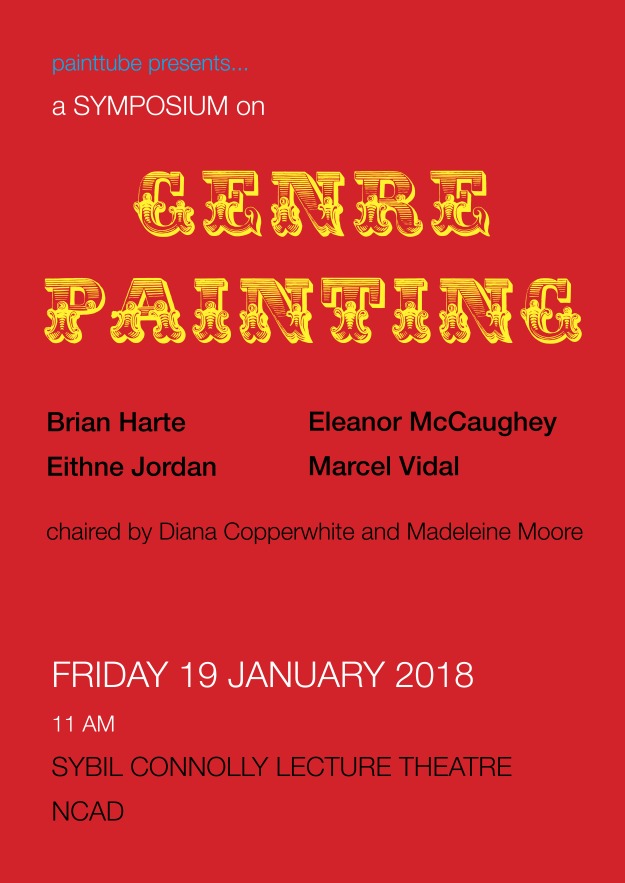
All Welcome to the upcoming Symposium on Genre Painting in the Sybil Connolly Lecture Theatre at NCAD next Friday 19th January at 11 am.


All Welcome to the upcoming Symposium on Genre Painting in the Sybil Connolly Lecture Theatre at NCAD next Friday 19th January at 11 am.
The theme of November’s MFA Painting seminar was Jerry Saltz’s article on neo-mannerism, Art’s Insidious New Cliché, published in http://www.vulture.com .
Read the text here.
Saltz berates artists for producing an ‘ever-expanding assembly of anaemically boring artistic clichés squeezing the life out of the art world right now.’
The question for us was, is this the case? If so, is Salz’s argument limited to New York? As one of the comments on his post states, ‘maybe you are not looking in the right place.’
In reference to painting, Saltz states, ‘Nowadays we see endless arrays of decorous, medium-sized, handsome, harmless paintings. It’s rendered mainly in black, white, gray or, more recently, violet or blue. Much of it entails transfer techniques, silkscreening, stencilling, assemblage, collage, a little spray painting or scraping and the like. There might be some smooshy blocks of colour or stripes or other obvious open-form abstraction or geometric motif.’ He then goes on to say that much of the current work references mostly male painters like Albert Oehlen, Christopher Wool, Michael Krebber, Wade Guyton, Laura Owens and Sergej Jensen.
Here is a summary of the arguments that were made ‘for’ and ‘against’ Jerry in our seminar. They do not necessarily reflect the views of the painting department or of everyone at the seminar.
FOR
In support of Jerry’s argument, we looked at a painting by Chantal Joffe, ‘Walking’ which was described as ‘dispassionate,’ in comparison to Maria Lassnig’s work. We looked at Sarah Faux, Patrick Brennan and Zachary Keeting.
Another group of works were shown: Luc Tuymans, Daniel Richter, Damien Hirst, and Thomas Hirschorn. The argument around these works is that they were ‘cynical.’ For example, that Tuymans seeming ability to paint any historical figure, here Condoleezza Rice, in monochromatic tones has become a mannerism.
We looked at the blog structureandimagery.blogspot.ie, a contemporary art blog by Paul Behnke, which showed images of recent shows in Lower Manhattan and it was proposed that from the work shown, Saltz did have a valid criticism to make of current shows in New York.
AGAINST
Against Saltz’s argument, we looked at Scott Stack, Richard Roth and Tomma Abts, all influenced by artists such as Christopher Wool, mentioned in the article, but not falling into any neo-mannerist cliché, it was suggested. Lynette Yiadom-Boakye, seen in this year’s Turner Prize, was also cited as an artist whose work, at least, challenged the viewer’s assumptions about what contemporary figure painting could be.
Chris Martin’s work has many influences from music, literature and film. He paints large-scale canvases and ‘paints on records, slices of white bread, pillows, aluminium foil, and uses copious amounts of glitter- materials that seem immune to artspeak’. In a recent interview by Ross Simonini, he was asked, “What’s your definition of ‘bad’ or ‘unsuccessful’?”
CM: ‘Well, that’s a wonderful question, because as an artist it’s very interesting sometimes to say, I’ll try to make a bad one. And often the kind of energy around the bad one is actually great.’
We also showed a group of works from the ‘Invisible- Art about the unseen, 1957-2012’ exhibition that was held at the Hayward Galley in 2012. The works were Jeppe Hein’s Invisible Labyrinth, Yves Klein, in the void room, 1961, Tom Friedman, 1000 hours, and Tino Seghal. The argument here was that if mannerism was a result of too much, an excess, then these works would offer some relief. They are visually low-key works, which invoke invisibility to underscore and direct our attention towards the unwritten rules that shape our understanding of art. A contrast to Jerry’s ‘post- formalist formal arrangements of clunky stuff, sticks, planks, bent metal, wood boxes, fabric old furniture, concrete things and whatnot leaned, stacked, piled or dispersed around a clean white gallery.’
Jerry mentions Bjarne Melgaard at the beginning of the article and we examined his work. He works, sometimes collaboratively, on large-scale expressionistic paintings. His works are said to be created from ‘authentic impulses.’
We also looked at images from NCAD Painting department recent graduate, Sam Keogh,’s 2013 show at the Kerlin Gallery, Dublin, ‘Mop.’ The exhibition takes its premise from the character of Oscar the Grouch in the children’s television series Sesame Street, a character who collected dirty, messy and useless objects and whose presence in the programmes was to teach children to tolerate non-normative behaviours. The show consists of a vinyl floor covering, printed from Keogh’s drawings spliced together, spread across the entire floor of the gallery, on which are placed an array of images, sculptures and found objects. Although the presentation of the show ticks several of Saltz’s boxes, the way forms merge in and out of the background of the floor covering, and the way the viewer discovers the show over time and spends time with it and on it, the subtlety of the shifts in scale and consideration of detail and materials , all counteract Jerry’s argument.
Posted by Madeleine Moore